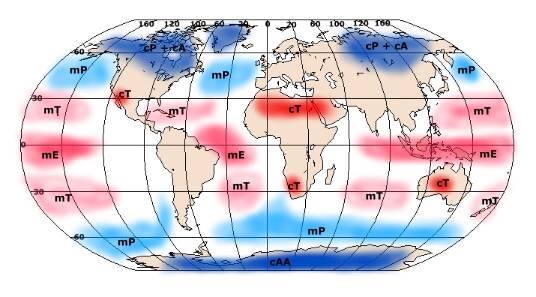Air Temperature and Air Mass MovementIf radiation was the only cause of temperature at a place, the daily and seasonal cycle of temperature would be very regular and exhibit the temporal pattern discussed earlier. The movement of large air masses across the surface can drastically change all this. The movement of a very cold air mass into a region can drop temperatures during the day when we expect the highest temperatures. Or if a warm air mass streamed over us at night, we might experience the highest temperature of the past 24 hours during the evening hours rather than during the daytime. An air mass is vast pool of air, covering thousands of square kilometers, having about the same humidity and temperature characteristics over its horizontal extent. Air masses are classified based on the temperature and humidity at their source region. Sources for air masses may be either oceanic or continental. Those that are oceanic tend to be moist while continental air masses are typically dry. Latitudinally, air masses form near the equator, in the subtropical zones, "polar" regions, and the Arctic and Antarctic. Most people think of the polar regions as those being located at the pole. For air masses, the polar source region is approximately 60 degrees north or south latitude. Combining the type of surface and latitude we derive a classification for the different kinds of air masses. A few are listed below and their geographic origin is shown in Figure 5.7. We'll deal with air masses in more detail when we investigate weather systems.
Figure 5.7 Global air mass source regions Influence of air masses on temperature at a place. The influence that air masses have on the temperature of a place depends the location with respect to the source of the air mass and the trajectory of the air mass as it moves from its source region. For instance, if one is located in the heart of an air mass source region, your climate will be fairly uniform throughout the year. If you lived in north central Canada you are located in the heart of the continental polar air mass (cP). You should expect temperature to be cool to cold, and the humidity relatively low throughout much of the year. However, if you live in central Illinois, you will experience a much greater variation in temperature because you are in the boundary zone between several different air masses. Two air masses in particular influence this region, cP and mT. The cP air brings cool, dry weather while mT air is responsible for humid and warm conditions. When these air masses collide, storms are generated.
|

